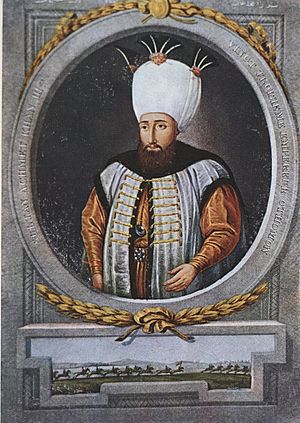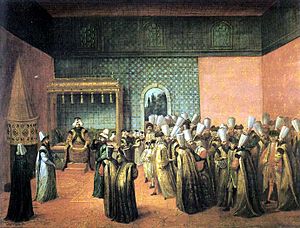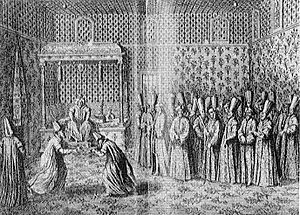Ahmed III facts for kids
Quick facts for kids Ahmed IIIاحمد ثالث |
|||||
|---|---|---|---|---|---|
| Amir al-Mu'minin Custodian of the Two Holy Mosques Ottoman Caliph |
|||||
 |
|||||
| Sultan of the Ottoman Empire (Padishah) | |||||
| Reign | 22 August 1703 – 20 September 1730 | ||||
| Predecessor | Mustafa II | ||||
| Successor | Mahmud I | ||||
| Born | 30 December 1673 Hacıoğlu Pazarcık, Ottoman Empire |
||||
| Died | 1 July 1736 (aged 62) Constantinople, Ottoman Empire |
||||
| Burial | Tomb of Turhan Sultan, Istanbul, Turkey | ||||
| Consorts | Mihrişah Kadın Şermi Kadın among others |
||||
| Issue Among others |
|
||||
|
|||||
| Dynasty | Ottoman | ||||
| Father | Mehmed IV | ||||
| Mother | Gülnuş Sultan | ||||
| Religion | Sunni Islam | ||||
| Tughra |  |
||||
Ahmed III (Ottoman Turkish: احمد ثالث, Aḥmed-i sālis) (30 December 1673 – 1 July 1736) was a Sultan of the Ottoman Empire. He was the son of Sultan Mehmed IV and Gülnuş Sultan, who was originally from Greece. Ahmed III was born in a place called Hacıoğlu Pazarcık, in Dobruja.
He became Sultan in 1703 after his brother, Mustafa II, stepped down. During his rule, from 1718 to 1730, a special time known as the Tulip Era took place. This period was led by Nevşehirli Damat İbrahim Pasha and Ahmed's daughter, Fatma Sultan.
When Ahmed III first became Sultan, he worked to calm down the Janissaries, who were powerful soldiers. He appointed Çorlulu Ali Pasha as his Grand Vizier (a top minister) to help him manage the government and money.
Contents
Early Life and Learning
Ahmed was born on December 30, 1673. His father was Sultan Mehmed IV, and his mother was Gülnuş Sultan.
He grew up in the Edirne Palace. His education started in Istanbul in 1679. He learned about the Qur’an, the teachings of Prophet Muhammad (called hadiths), and Islamic studies. He also studied history, poetry, and music with private teachers. One of his teachers was a chief mufti (a religious scholar) named Feyzullah Efendi.
Ahmed was a very curious and smart person. He spent a lot of time reading and practicing calligraphy (beautiful handwriting). The poems he wrote showed how much he knew about poetry, history, and Islamic ideas. He learned calligraphy from famous artists like Hafız Osman Efendi. His older brother, Mustafa II, who would also become Sultan, was also a calligrapher.
During his time as a prince in Edirne, Ahmed became friends with a clever officer named Ibrahim. Ibrahim later became one of the most important Grand Viziers during Ahmed's rule. After his father was removed from power in 1687, Ahmed lived quietly for sixteen years. During this time, he focused on calligraphy and learning.
Becoming Sultan
Taking the Throne
The change in power happened in Edirne between August 19 and August 23, 1703. Before Ahmed, Istanbul had many problems, like rising crime and unhappy people. The Janissaries removed Sultan Mustafa II, and Ahmed became the new Sultan on August 22, 1703.
Ahmed worked to improve the Ottoman Empire's laws. In 1705, he changed land ownership rules. This helped reduce crime and bring peace. Because he strongly supported these new laws, Ahmed was called 'law-giver'. Only three other sultans had this title before him. In his first three years, Ahmed chose four different Grand Viziers. The government became stable after Çorlulu Ali Pasha was appointed in May 1706.
War with Russia (1710–1711)
Ahmed III had good relationships with France because Russia was becoming a threat. He gave shelter to Charles XII of Sweden after Sweden lost a big battle to Peter I of Russia in 1709. In 1710, Charles XII convinced Sultan Ahmed III to declare war on Russia.
The Ottoman army, led by Baltacı Mehmet Pasha, won a major victory at the Battle of Prut. After this, Russia gave Azov back to the Ottomans. Russia also agreed to destroy some fortresses and stop getting involved in the affairs of the Polish-Lithuanian Commonwealth.
Ahmed III was close to defeating Russia completely. However, news arrived that the Safavids were invading the Ottoman Empire. This caused panic and made the Sultan focus on the Safavid threat instead of Russia.
Wars with Venice and Austria

On December 9, 1714, the Ottomans declared war on Venice. An army led by Silahdar Damat Ali Pasha successfully took back the Morea (Peloponnese) from Venice.
This success worried Austria. In April 1716, Emperor Charles VI caused the Ottomans to declare war on Austria. This war, also led by Silahdar Ali Pasha, was not successful. It ended with the Treaty of Passarovitz on July 21, 1718. With this treaty, the Ottomans lost Belgrade, Banat, and Wallachia to Austria. This loss was a big disappointment for Ahmed. The economy in Istanbul suffered from rising prices after this treaty.
Ibrahim Pasha, who was a very important figure, had seen the financial problems of the empire. Because of this, he tried to avoid wars as much as possible when he became Grand Vizier. Ahmed also preferred peace because he was interested in art and culture and did not want to leave Istanbul for military campaigns.
Ahmed's Way of Ruling
Ahmed III worked to improve the morale of his soldiers and people. He also launched new warships. He changed Grand Viziers several times in his early reign.
Ahmed III left the Ottoman Empire's finances in good shape. He did this without raising taxes too much. He was a great supporter of literature and art. During his time, the first printing press that could print in Arabic or Turkish was set up in Istanbul by Ibrahim Muteferrika. Before this, printing presses in Istanbul only printed in Greek, Armenian, or Hebrew.
During Ahmed's rule, there was an important change in how the Danubian Principalities (regions like Moldavia and Wallachia) were governed. After the war with Russia in 1711, the Ottomans started appointing Greek officials from Istanbul to rule these areas. These officials were known as Dhimmi nobility and helped the Ottoman government in many ways.
Relations with the Mughal Empire
Jahandar Shah
In 1712, the Mughal Emperor Jahandar Shah sent gifts to Sultan Ahmed III. He called himself a devoted admirer of the Ottoman Sultan.
Farrukhsiyar
Another Mughal Emperor, Farrukhsiyar, also sent a letter to the Ottomans. This letter was received by the Grand Vizier Nevşehirli Damad Ibrahim Pasha. It described the efforts of the Mughal commander Syed Hassan Ali Khan Barha against rebellions.
Losing the Throne
Sultan Ahmed III became unpopular because he and his top officials enjoyed too much luxury and spent a lot of money. On September 20, 1730, a group of Janissaries, led by Patrona Halil, started a riot. Citizens and other soldiers joined them. The riot grew into a large uprising, and the Sultan was forced to give up his throne.
Ahmed willingly handed over power to his nephew, Mahmud I. He then moved into the Kafes (a special part of the palace where princes were kept in isolation). He died there after six years, on July 1, 1736.
Buildings and Art
Ahmed III built many water fountains and park waterfalls. He also built three libraries, including one inside the Topkapı Palace. He was a master of calligraphy, and some of his writings on plates and inscriptions still exist today.
The Topkapı Palace and its buildings have been studied a lot. The Ahmed III library, built in 1724–1725, is one of its interesting parts. It has unique designs and valuable old books.
Disasters during his reign
In 1714, a ship caught fire near a pier in Istanbul, and two hundred people died.
Great Fire of 1718
While Nevşehirli Damat Ibrahim Pasha was preparing to return to Istanbul, a huge fire broke out. Many areas of Istanbul, including Unkapanı, Fatih, and Langa, were burned down.
Earthquake of 1719
Soon after the fire, a big earthquake happened on May 14, 1719. The city walls of Istanbul were damaged. About 4,000 people died in Izmit, and Yalova was destroyed. After the earthquake, rebuilding started in Istanbul. The Topkapı Palace Enderun Library, also known as Sultan Ahmed-i Salis Library, was built that year. It was given many valuable manuscripts.
Family Life
Ahmed III is known for having a very large family among the Ottoman Sultans. The head of his harem was Dilhayat Kalfa, a famous Turkish composer.
Wives (Consorts)
Ahmed III had many wives. Some of the most important ones included:
- Emetullah Kadın: She was his first and most loved wife, and the mother of his favorite daughter, Fatma Sultan.
- Mihrişah Emine Kadın: She was the mother of four sons, including Mustafa III, who later became Sultan.
- Rabia Şermi Kadın: She was the mother of Abdülhamid I, who also became Sultan.
Sons
Ahmed III had many sons. Most of them were buried in the Yeni Cami. Two of his sons, Mustafa III and Abdülhamid I, later became Sultans. Many of his sons lived in the Kafes, a part of the palace where princes were kept isolated to prevent them from challenging the Sultan.
Daughters
Ahmed III also had many daughters. His favorite daughter was Fatma Sultan. She was very powerful during the Tulip Era with her second husband. After her father was removed from power, she was confined to a palace. Other notable daughters included Saliha Sultan and Ayşe Sultan.
Death
Ahmed lived in the Kafes of the Topkapi Palace for six years after he was removed from power. He became ill and died on July 1, 1736. He was buried in his grandmother's tomb in the Turhan Sultan Mausoleum in the New Mosque in Istanbul.
In Fiction
In Voltaire's book Candide, the main character meets the deposed Ahmed III on a ship. This story was also used by the Turkish writer Nedim Gürsel in his 2001 novel Le voyage de Candide à Istanbul. However, there is no real proof that the deposed Sultan was allowed to travel outside the palace.
See Also
 In Spanish: Ahmed III para niños
In Spanish: Ahmed III para niños
- Fountain of Ahmed III
- Fountain of Ahmed III (Üsküdar)
- Ibrahim Muteferrika
- Esma Sultan, daughter of Ahmed III
Images for kids
-
A miniature of Sultan Ahmed III by Levni





